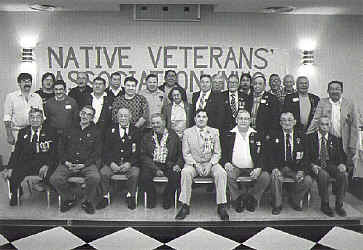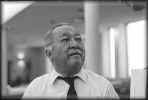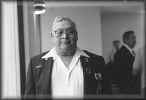THE ORIGIN OF THE NATIVE VETERANS ASSOCIATION
OF NORTHWESTERN ONTARIO

Native Veterans Association
Founding Meeting: Prince Arthur Hotel 1988
Photo Credit: Bill Lindsay |
The origin of the Native Veterans Association of Northwestern Ontario can be placed
squarely on the shoulders of one man. That man was Willy John. Charles "Willy"
John was a Native Veteran of World War II. He had dreamt for ten years about forming an
organization for the Native Veterans of Northwestern Ontario. Willy had lived within the
Northwestern Ontario region for his entire life. He knew Native Veterans had special
concerns which were not being addressed.

Charles "Willy" John
|
Willy began to extensively research the
involvement and contributions of Native Soldiers in Canada's Armed Forces. Willy initiated
his research in the Thunder Bay Museum and Thunder Bay Public Libraries. In his efforts,
he found some startling documents which dated Native participation in Canada's Military
conflicts to the War of 1812. As his research continued, Willy found evidence which
revealed an extremely high percentage of Native men were in service during World War I and
World War II. Of these men more than 50 percent were decorated. |
Those revelations of Native Veterans participation were certainly not common knowledge. It
was certainly not taught within the school system. According to records from the Annual
Report of the Department of Indian Affairs 1920, from a population of
100,000 Indian people, slightly over 28 percent enlisted in the First World War. This
staggering percentage does not include the Native people who were not living on reserves
or the Metis. Over 50 percent of the Native people who fought in the Second World War were
decorated. These numbers alone justify some recognition. The Indian community of Canada
was behind the war effort, even if they did not have full Canadian citizenship and could
not vote in the country for which they fought (Indians were given the right to vote July
1st,1953). These are just a some of the facts that very few people in Canada are aware of.
Of the Ojibways from Ontario who enlisted, most of them went overseas. Especially
noteworthy was the high rate of enlistment for the Lakehead area and the Nipigon district.
The majority of these joined the 52nd Battalion. As in the case of Sergeant Leo Bouchard,
from Lake Nipigon, as part of the 52nd he won the Distinguished Conduct Medal (DCM) for
conspicuous gallantry and devotion to duty. The village of Kejick on Shoal Lake was
named in the honour of Private David Kejick of the 52nd Battalion. He was awarded the DCM
because he displayed marked courage and intelligence during the attack on enemy
positions at Tilloy on the 1st of October, 1918. Enlisting and fighting for their
country was what the young Native men and women of this area did in the years of the World
Wars.
| Native
people who enlisted, particularly those from remote northern areas, had to face severe
culture shock and hardships not encountered by English speaking Canadians, as they adapted
to military life. Many faced the invisible wall of the language barrier. Formal education
and media not being a part of their way of life in remote areas, meant they virtually had
no understanding of the English language spoken in the armed forces. |

Native Veteran
Lawrence Martin
|
When William Semia
from Cat Lake enlisted, he did not understand English and had to be assisted by a fellow
Ojibway speaking member with basic training. For many days after he joined, while waiting
to be sent to basic training, Private Semia was afraid of being lost in the city and did
not leave the armory without another soldier. Pte. Semia went on to make the
Trans-Atlantic crossing on the troopship Olympic, fight for his country and was seriously
wounded before returning to Canada. William Semia's story is not unusual, many Native
people from this area enlisted knowing they would face these language and cultural
barriers, it was sufficient for them that a state of war existed and they could help.
Willy found that one of the most highly decorated Canadian soldiers was
Tommy Prince, a Saulteaux Indian from Manitoba. Willy himself had not known about Tommy
Prince prior to his research, but he knew only too well about the Native Soldiers
"honourarium" upon their return from the war.
The "honourarium" for the Native Soldier meant that he could not vote upon his
return unless he was enfranchised. Enfranchisement resulted in the loss of Status Indian
Rights under the Indian Act. This would also impact the status rights of all his
descendants. The loss of Status Rights under the Indian Act did not often impact or result
in the loss of Treaty Rights.
Other Indian Act restrictions included the prohibition of the consumption of alcohol and
denied ownership of property. This restriction for owning property meant that the Native
Soldier could not be entitled to a portion of land like other veterans unless he had given
up his status. If the Native Veteran chose to retain his status, the allotted land was
annexed to the reserve and subsequently belonged to the band. This land issue, along with
many other benefits to which the Native Veteran was entitled to, was lost in the
administration between the Department of Indian Affairs and the Department of Veteran
Affairs. Both Departments conflicted as to who held governmental jurisdiction. The Native
Veterans were not aware of the benefits available to them due to socio-cultural, language
and geographical barriers.
There has been no doubt that Native Soldiers were not equally treated as other Veterans.
Perhaps this contributed to their unwillingness to self-identify as a Veteran. As such,
these Veterans coped regardless of their circumstances and simply carried on with their
lives.
|

